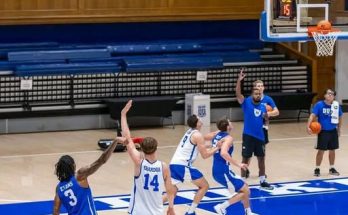JUST IN: Oklahoma Sooner Football Unveils a $5.3 Billion, State-of-the-Art Renovation to Oklahoma Sooner Stadium, Redefining the Standard for College Football
In a move that has sent shockwaves throughout the college football landscape, the University of Oklahoma has announced a jaw-dropping $5.3 billion renovation project for Oklahoma Sooner Stadium, the revered home of the Sooners. This monumental upgrade not only redefines expectations for collegiate athletic facilities but also solidifies Oklahoma’s intent to lead the way as it transitions fully into the SEC era.
With enhancements ranging from luxury suites and expanded seating to futuristic fan experiences powered by artificial intelligence and augmented reality, Oklahoma is swinging for the fences—and they’ve likely just hit a grand slam.
The Biggest Renovation in College Football History
The price tag alone is unprecedented. At $5.3 billion, this renovation dwarfs any other stadium upgrade in college football history. By comparison, previous massive projects like Texas A&M’s Kyle Field redevelopment ($485 million) or LSU’s Tiger Stadium enhancements (around $100 million) seem modest.
Athletic Director Joe Castiglione, in a press conference filled with energy and anticipation, called the project a “moonshot” and a “defining moment not only for Oklahoma Athletics, but for college football as a whole.”
“We aren’t just building a stadium,” Castiglione said. “We are creating the future of sports entertainment—an immersive, luxurious, tech-forward experience that reflects the pride and ambition of Sooner Nation.”
Key Features of the New Sooner Stadium
The renovation, slated for completion by the 2027 season, will include multiple transformational features that make it a category-defining venue. Here’s a breakdown of what’s to come:
1. Luxury Suites & VIP Experiences
- Over 160 brand-new luxury suites, many of which include private elevators, exclusive dining, and concierge services.
- “SkyLofts” – glass-enclosed lounges that float above the field on the east and west sides of the stadium.
- Club seating options with in-seat food and drink delivery and private restrooms.
- A dedicated VIP entrance with valet parking and an underground tunnel leading to elite-level lounges.
2. Seating Capacity Expansion
- The stadium’s seating will increase from 86,000 to over 102,000, making it one of the largest stadiums in the country.
- Each seat has been reengineered for comfort with improved legroom, cupholders, and temperature-controlled cushioning in premium areas.
3. Cutting-Edge Fan Technology
- Integration of augmented reality (AR) for in-game overlays via mobile apps, including player stats, replays, and customizable viewing angles.
- In-stadium 5G+ connectivity for lightning-fast access to digital content.
- Facial recognition technology for entry to seats and suites, removing the need for tickets.
- AI-driven crowd flow analysis to reduce congestion and optimize fan movement.
4. The Sooner Sphere: A Digital Halo
- The highlight of the stadium will be the “Sooner Sphere”—a 360-degree digital halo scoreboard that wraps the entire upper rim of the stadium.
- Capable of displaying live stats, graphics, fan cams, and synchronized LED light shows during night games.
5. Green and Sustainable Infrastructure
- Solar-paneled rooftops on all new structures.
- A net-zero carbon emissions target by 2030.
- Rainwater recycling systems and eco-friendly turf innovation.
A Nod to Tradition in a Modern World
Despite the futuristic lean, university officials stressed that the new design does not forget its roots. Iconic elements of the original Gaylord Family Oklahoma Memorial Stadium will be preserved and enhanced:
- The south end zone’s “O-K-L-A-H-O-M-A” letters, visible since the stadium’s early days, will now be outlined in programmable LED lights.
- Barry Switzer Plaza will be expanded and transformed into a museum-like entrance that celebrates the Sooner legacy with interactive digital exhibits and memorabilia.
- A dedicated “Legacy Walk” will showcase statues of every Heisman winner and Hall of Famer, encircling the stadium’s perimeter.
SEC Era Demands SEC-Level Infrastructure
This upgrade is more than just architectural bravado—it’s a strategic move. As the Sooners settle into the SEC, the most competitive and resource-rich conference in the nation, the university is preparing for a new era in recruiting, fan engagement, and television partnerships.
Head Coach Brent Venables voiced his excitement:
“This stadium is going to be a game-changer on every level. Recruits walk in and realize this is the future. Opponents walk in and feel the pressure. Our fans walk in and get the experience of a lifetime.”
Not only does this build help in recruiting elite athletes, but it also positions Oklahoma as a central figure in national broadcasts and corporate sponsorships. The stadium’s naming rights are still available, and early reports suggest they could fetch north of $1.2 billion over 20 years, offsetting a large portion of the project cost.
Economic Impact on Norman and Oklahoma
The economic ripple effects of this historic renovation could be enormous. University economists estimate:
- Over 8,000 temporary construction jobs will be created.
- Long-term job growth in hospitality, tech services, and maintenance.
- Estimated annual revenue for Norman’s economy could jump by $150 million through increased tourism, lodging, and game-day activity.
- “The Sooner Quarter,” a new entertainment district, will rise adjacent to the stadium, featuring retail, restaurants, hotels, and a year-round Sooner Hall of Fame.
Critics Raise Eyebrows—but Enthusiasm is Overwhelming
As with any mega-project, criticism is unavoidable. Some question the optics of spending $5.3 billion on a sports stadium when higher education is grappling with budget constraints. Others express concerns over gentrification and increased cost of living in Norman due to economic shifts.
University President Joseph Harroz Jr. addressed these concerns directly:
“We understand the importance of balancing ambition with responsibility. This stadium is funded through private donors, naming rights, corporate partnerships, and targeted investments—not tuition hikes or cuts to academics.”
He also emphasized that revenue from the stadium will directly fund scholarships, academic programs, and student well-being initiatives through a profit-sharing model.
The Visionaries Behind the Project
The architectural lead for the stadium project is Populous, a world-renowned design firm responsible for facilities like Tottenham Hotspur Stadium in London and Allegiant Stadium in Las Vegas.
In collaboration with OU’s College of Architecture, student designers will also contribute ideas and designs for internal spaces, giving the project an educational element.
Lead donors include several high-profile Sooner alumni and Oklahoma-based companies. Oil magnate Charles Harris reportedly contributed over $500 million, while other support has come from figures like Blake Shelton, Baker Mayfield, and the Love’s Travel Stops family.
Timeline: What’s Next?
The construction will begin following the 2025 season, with phased updates designed to minimize disruptions:
- 2026: South End Zone and Sooner Sphere completed.
- 2027: Entire east and west sideline seating restructured.
- 2028: Final luxury elements and the Sooner Quarter entertainment district open.
The Sooners plan to continue playing home games at the stadium throughout construction, using modular design phases to close only one section at a time.
A Once-in-a-Generation Statement
This renovation project is not just a facelift—it’s a manifesto. It declares that Oklahoma is not content to keep pace with tradition but is ready to shape the future of college football.
With their SEC move, elite recruiting classes, and now the most audacious stadium project ever attempted in college athletics, the Sooners are positioning themselves to lead both on and off the field.
As the sun sets on the old era and rises over the new Sooner Stadium, one thing is certain: college football will never be the same again.



